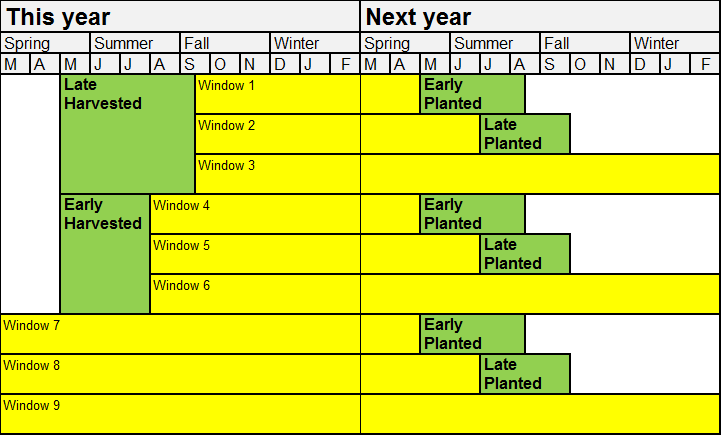Cover crop innovations on vegetable farms: What’s new?
Learn about innovative cover cropping strategies for vegetables at MSU Agriculture Innovation Day on June 28.

Cover crops can play a vital role in building and maintaining soil health. However, success depends on finding the right cover crop for the right window to achieve your desired results. On June 28, MSU Agriculture Innovation Day: Focus on Fruit and Vegetable Technologies in Benton Harbor, the afternoon cover crop session, “Cover Crops: Making Cover Crops a Priority,” will demonstrate innovative strategies for vegetable growers to integrate diverse cover crops into their production systems. The following key take home messages will be highlighted:
Cover crop choices should be guided by management goals and planting windows
When selecting cover crops, it is important to keep in mind two key questions:
- What are your primary management goals?
- What are your windows of opportunity for planting?
Cover crops can be divided into different “functional groups” based on their primary benefits (e.g. N-fixation, biofumigation, soil organic matter building) and their period of optimal growth (e.g. cool season, warm season). On vegetable farms with short duration crops in diverse rotations, planting windows (Figure 1) and management goals vary from farm to farm and field to field. To help growers navigate cover crop choices to enhance their performance in vegetable systems, the Midwest Cover Crop Council’s online cover crop selector is a useful tool. At the field day we will discuss the underlying principles of cover crop selection while looking at a demonstration plot with various cool season cover crops representing different functional groups.

Figure 1. Windows of opportunity for planting cover crops (yellow boxes) in vegetable crop rotations (green boxes) range from very narrow (Window 1: late-harvested cash crops followed by early planted vegetables) to very wide (Window 9: multi-year fallow).
Cover crop mixtures (or “cocktails”) can enhance cover crop benefits
There is increasing excitement among growers, seed companies and researchers on the potential for multi-species mixtures of cover crops to boost benefits relative to single species plantings. For example, a recent survey of cover crop practices found that 65 percent of growers using cover crops planted mixtures in 2016, and that among these, 22 percent had tried mixtures of six or more species. Research and grower experience suggests that mixtures of 4-5 species representing different functional groups (e.g. nitrogen fixers, biofumigants, soil organic matter boosters) have potential benefits relative to monocultures of single species, including reduced risks of cover crop failure, enhanced soil microbial activity or promotion of beneficial insects. However, the optimal number of cover crop species in different situations is debatable. Planting species for the sake of increasing diversity may be counterproductive if those species do not match the planting window or if they host insect or disease pests of related vegetables in rotation. At the field day, we will look at demonstration plantings of monocultures vs. mixtures of cover crops and discuss the costs and benefits of specific mixtures in the context of vegetable production systems.
Advances in “precision” cover cropping may further enhance cover crop performance
Recent research suggests that greater attention to cover crop establishment methods and fertilization can enhance cover crop performance. For example, managing soil fertility to improve cover crop growth can go a long way toward improving potential benefits. In on-farm trials evaluating the impact of various cover crops in carrot rotations, weed suppression, N retention, and yield improvements were greatest following cover crops that had been planted early and fertilized, compared to those that were not. Greater availability of precision seeders and tractor guidance systems also improve the potential for optimal plant spacing or alternative planting arrangements that may enhance performance. For example, segregated plantings of cover crop species into distinct zones can target cover crop services to the areas of the field where they are needed most, enhancing mixture performance while saving money on seed (see Figure 2).
At MSU Agriculture Innovation Day, farmers will have the opportunity to see cover crop species options for early spring, including mixtures. There will also be the opportunity to see the effects of soil fertility and cover crop segregated plantings on cover crop growth. Additional information on cover cropping from MSU can be found at the MSU Extension Cover Crops website, which showcases cover crop resources and ongoing research at MSU. You can also follow the MSU Cover Crops team on Twitter @MSUcovercrops.
MSU Agriculture Innovation Day: Focus on Fruit and Vegetable Technologies, 8:30 a.m.-5 p.m. June 28 at the MSU Southwest Research and Extension Center in Benton Harbor, Michigan, offers a variety of fruit, vegetable and grape growing technologies, including the latest information on pollinators and equipment. The event has been approved for Restricted Use Pesticide Credits (6 credits) and Certified Crop Advisor CEUs in Integrated Pest Management, Crop Management, Soil and Water Management and Sustainability. For detailed session descriptions, visit http://www.canr.msu.edu/msu_agriculture_innovation_day/ or contact Ron Bates at batesr@msu.edu.
This work is supported by Project GREEEN and the Crop Protection and Pest Management Program 2017-70006-27175 from the USDA National Institute of Food and Agriculture. Any opinions, findings, conclusions or recommendations expressed in this publication are those of the author(s) and do not necessarily reflect the view of the U.S. Department of Agriculture.



 Print
Print Email
Email



